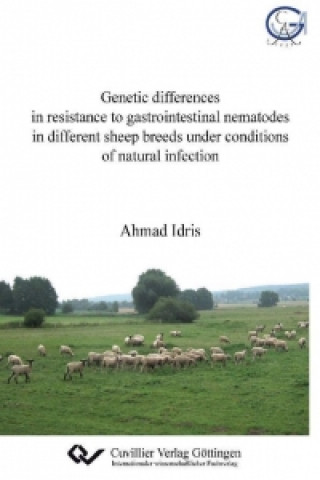
Livrare
Consilier de cumpărături





Nu se pretează? Nu contează! La noi puteți returna bunurile în 30 de zile
 Voucher cadou
orice valoare
Voucher cadou
orice valoare
Cu un voucher cadou nu veți da greș. În schimbul voucherului, destinatarul își poate alege orice din oferta noastră.
Genetic differences in resistance to gastrointestinal nematodes in different sheep breeds under conditions of natural infection
 engleză
engleză
 51 b
51 b
30 de zile pentru retur bunuri


The objectives of the present study were to determine the prevalence of gastrointestinal nematodes (GIN) in naturally infected lambs of five sheep breeds based on individual faecal egg counts (FEC) in Germany, and to evaluate the predictable influence of birth type, age, sex and breed of lambs on the excretion of nematode eggs in the faeces. Furthermore, the use of potential infection indicator traits such as the dag score (DS), the faecal consistency (FCS), the body condition (BCS) and the FAMACHA(c), either separately or combined, to detect individually lambs in need for drenching when exposed to natural nematode infections was investigated. Additionally, the possibility of breeding for resistance against GIN in German sheep breeds directly based on faecal egg counts (FEC) or indirectly by using DS, FCS, BCS and FAMACHA(c) was also evaluated. Moreover, the relationships between the nematode infection with Haemonchus contortus and body and organ measurements of lambs were estimated. The field trials under natural conditions of nematode infections (Chapters II, III and IV) were carried out on 3,924 lambs of different breeds aged from 3 to 15 months. The breeds used were Merinoland (ML), German Blackhead Mutton (GBM), Texel (TX), Rhoen (RH), and Merino long-wool (MLW). Data collection took place on various farms. The samples were collected once during the grazing seasons in 2006, 2007 and 2008. At the time of faecal sample collection, the FAMACHA(c) score, the BCS, the DS and FCS were additionally determined and served as potential infection indicator traits. The lambs were not dewormed at least 45 days before the sampling time. Sixty-three percent of the lambs were infected with GIN. The infections were mostly low to moderate and involved different species. Trichostrongylus spp. were the predominant species based on the percentage of larvae in the faecal cultures. Only 11.4% of faecal samples were Eimeria oocysts free. Tapeworm eggs were encountered in 13.2% of all samples. The farms affected the prevalence of GIN infections significantly (P < 0.001). Significantly higher FECs (P < 0.05) were observed in multiple lambs when compared with singletons. Moreover, male lambs were more susceptible to infection than females (P < 0.001). The FECs were negatively correlated with the age of the lambs (P < 0.001). No significant differences (P > 0.05) were observed between breeds in regard to FEC. The decision of drenching based on each of the potential indicator traits yielded low sensitivities (13 to 39%) and high ratios of false negative results (13 to 19%). The sensitivities of the indicator combinations were higher (67 and 69%) than those for the individual indicator traits and were positively associated with the intensity of infection. However, the indicator combinations were not specific enough and had high ratios of false positives (37 and 39%). The estimated heritabilities for FEC ranged from 0.22 to 0.59 among breeds. Heritabilities for the indicator traits DS, FCS, BCS and FAMACHA(c) ranged between 0.15 to 0.50, 0.16 to 0.24, 0.02 to 0.55 and 0.01 to 0.25, respectively. The phenotypic correlations of FEC with the potential infection traits were on a low level. A negative correlation was found between BCS and FEC in three breeds (P ? 0.01). FEC did not show a consistent genetic correlation with the other traits and in most cases estimated values had high standard errors. Genetic correlations between DS an FCS were high ranging between 0.50 and 0.95. For determining the correlations among parasitological and morphological parameters (Chapter V) 100 lambs from five different genotypes (ML, TX × ML, Suffolk x ML, GBM x ML and Ile de France × ML) were experimentally infected with 5,000 infective 3rd stage larvae of H. contortus at the time of weaning (12 weeks of age). Four and six weeks after infection, individual faecal samples were collected for estimation of FECs. Furthermore wither height, shoulder width, heart girth, loin girth and body length were recorded at eighteen weeks of age. Lambs were slaughtered and necropsied seven weeks post-infection, and worm counts, abomasal volume and surface area were determined. Positive correlations were found between different body size parameters, body weights and abomasal sizes. FEC and worm counts were neither significantly correlated with body size parameters nor with abomasal size. The mean worm burden in ML lambs was higher than does in crossbred lambs, whereas there was no significant difference in abomasal size between ML and crossbred lambs.
Informații despre carte
 engleză
engleză




 Cum să cumpăr
Cum să cumpăr















